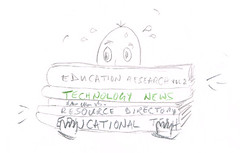This is an updated version of a previously-published article.
Update!
Three additions have been made, these being characteristics that have come to light since the original article was published. These are designated with the word “New”.
Radio interview, by Terry Freedman
What are the attributes of a good scheme of work for Information & Communications Technology (ICT) or Computing? Here's the list of characteristics I've always looked for:
It must address the requirements laid down by the District or State or Government.
Now, say you teach in England, and you have an absolutely brilliant scheme of work for Computing. Only, it doesn't match the National Curriculum's Programme of Study for Computing at all. Then perhaps you are going to have to go back to the drawing board on that one.
However, I'm now going to cheat! Because what I would say is, if the scheme of work is brilliant but doesn't seem to match the Programme of Study, you have a couple of choices:
·Take a closer look at the scheme of work alongside the Programme of Study. Are you absolutely certain there is no correlation? Perhaps concepts are disguised, or in the "wrong" order. But can you still map the scheme of work to the Programme of Study, at least partially?
If you’re in an academy or a free school or a private school, you don’t have to follow the National Curriculum. However, bear in mind that (a) pupils from these schools will, at some point and in some way, be competing with those who have followed the National Curriculum and, (b), those schools are still subject to inspection. However, one of the good things about the Computing Programme of Study is that it is so thin that you fit almost anything into it.
It should be appropriate but challenging
At the risk of stating the obvious, it's not good enough to have a scheme of work that just addresses students' current needs and abilities. It needs to be able to stretch them and be able to be adapted as students' grasp of the subject grows. Think Bruner’s spiral curriculum, and Vygotski’s Zone of Proximal Development.
It must be relevant
In my opinion, one of the best ways of waking a scheme of work relevant is to make sure that at least some of it utilises students' own experiences, interests and environment.
There should be lots of opportunities for developing projects or mini-projects
You can cover the Computing Programme of Study with a series of well-thought out projects alongside other forms of teaching and learning. A good scheme of work will suggest how you might develop or localise particular aspects of its content to your circumstances.
New: There should be scope for branching out
By this, I mean opportunities for doing things like making videos, podcasts, radio programmes or newspapers. Those kind of things can also be useful for assessment purposes. This has been added as a means of enriching the learning experience of pupils.
New: There should be “hooks” for other subjects
For example, an obvious link to Computing would be maths. Can you develop a module of work with the maths department or subject leader for maths? A perhaps less obvious link would be with English, but there are forms of poetry that have structures which lend themselves to being viewed through a programmatic lens. Also, work has been done analysing novels. For ICT especially there are potential links to geography, while history lends itself to database research and analysis of historical documents. This has been added to enable ICT and Computing teachers to think of ways of linking up with teachers of other subjects.
It should have built-in training opportunities
For example, if one of the items is about teaching how to create simple Scratch programs, there should either be a tutorial right there, or at least a link to a YouTube clip or other useful resource.
It should be more than just a checklist
Avoid any scheme of work that tells you hat once you and your students have completed Unit X, you have "done" algorithms, Scratch programming or whatever. There should, instead, be opportunities to revisit concepts and skills at higher and more complex levels as the course goes on.
Ideally, it should involve collaboration
While it's true that a camel is a horse designed by a committee, there's a lot to be said for having several people involved in the creation of a scheme of work.
If you are fortunate enough to have a team to work with in your school, consider having each team member take responsibility for a half-term unit, ie one lasting around 6 weeks. If they are in charge of not only content but teaching materials and CPD for the rest of the team, and given a free hand over how they choose to address the concepts concerned, you can end up with a very rich and complete scheme of work indeed.
If you do not have a team within your school to work with, or even if you do, try to work with other people – even if you're the expert and they are not. Why? Because they can bring a perspective and an area of expertise that you cannot. See the next point too in relation to this.
New: There should be lots of examples and analogies from different fields
This has been added partly to enable under-confident teachers to feel that they can contribute something to the subject, and partly to maximise the chances of students being interested and developing an understanding.

Your newsletter editor is hard at work doing research for Digital Education, the free newsletter for education professionals. Have you subscribed yet?
Read more about it, and subscribe, on the Newsletter page of the ICT in Education website.
We use a double opt-in system, and you won’t get spammed.

